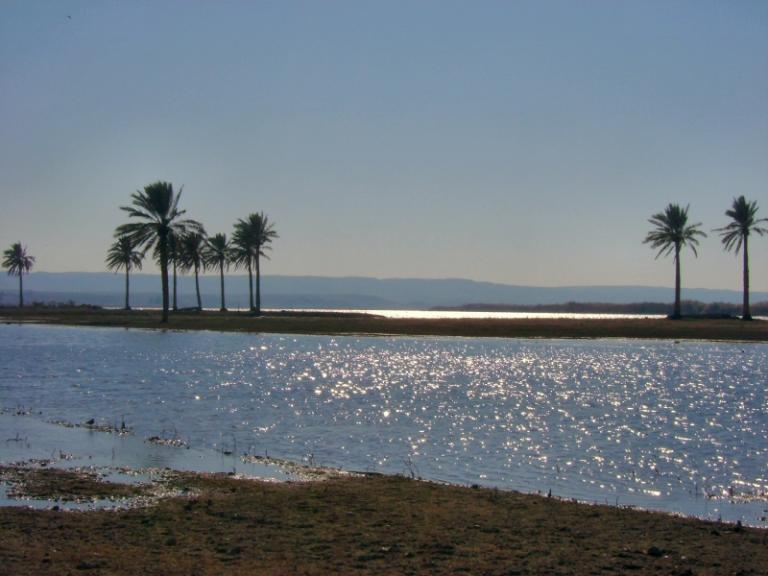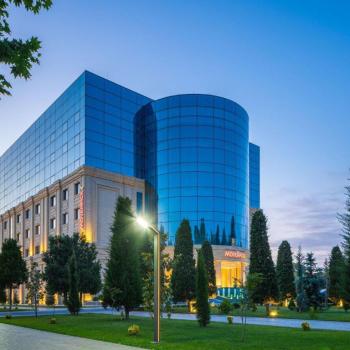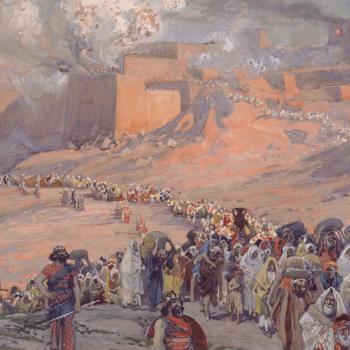
(Wikimedia Commons public domain photo)
The Arab expansion continued in the early years of the High Caliphal Period. Muslim soldiers moved up the valley of the Oxus River into Central Asia, and continued their march across North Africa into Morocco, where they conquered and converted the tribal Berbers. Thus, the entire northern coast of the African continent, once a stronghold of Christianity and the home of such major Christian figures as Tertullian and St. Augustine, fell under Muslim control. In the year 711, Berber Muslim forces crossed the Straits of Gibraltar and conquered much of what we know today as Spain and Portugal. Arabic-speaking Muslims would rule the Iberian peninsula until 1492—a nearly eight-century stay that had a profound impact on literature, language, and culture, there and in Latin America. (The splashing tiled fountains in the central courtyards of Spanish colonial buildings, cool and green behind thick walls, are right out of the Arab world.)
It must be stressed, however, that these were Arab conquests, not Islamic conquests. As noted, the Qur’an prohibits forced conversions. But the Umayyads[1] did not even encourage conversions. To understand this, it must be remembered that the Umayyads were the descendants of Muhammad’s old enemies, who had opposed him virtually throughout his ministry. Finally, when they saw no alternative, they converted to Islam. But their lifestyle always gave plenty of reason for suspecting that their conversion was only skin-deep. The empire at times seemed to be merely an unusually large family business, with hereditary succession of Umayyads at the top. They apparently regarded Islam as a religion for the Arab ruling class. But even so, their attitude toward the religion was somewhat free. Many of the caliphs of the Umayyad dynasty have lived on in Islamic tradition as symbols of debauchery. They became notorious for drunkenness.[2] While the subject peoples at first continued in whatever Hellenistic or Sassanian cultural patterns that they had inherited, perhaps looking up only briefly to notice a change of rulers, the Umayyads too tried to maintain the old ways. In this case those old ways were the ways of the desert.
However, there was something artificial about this nostalgia for the simple past. It was inconceivable that the rulers of much of the known world could go on living in the manner of their old desert- dwelling tribal ancestors. And it is not even certain that they really wanted to. Near Jericho, the ruins of the hunting palace belonging to the Umayyad caliph Hisham are still to be found. They certainly suggest something a bit more lavish than a bedouin tent. One is reminded of Marie Antoinette playing at being a peasant girl, surrounded by an elaborate mock village on the grounds of the palace of Versailles. Or, perhaps, of the Hearst family “roughing it” in circus-size tents, camping on the beach at San Simeon accompanied by dozens of servants.
Change was inevitable. The subject peoples began, slowly, to convert to Islam. There were good reasons for this, of course. Being Muslim was the key to social advancement. Even more tangibly, converts escaped the dhimmi taxes imposed by Islam upon non-Muslims in order to support the military and other institutions from which non-Muslims were exempt. (Such escape was permitted only after considerable Umayyad resistance. Far from forcing conversions, the Umayyads demonstrated by their resistance that they were actually more concerned about money, about fiscal revenues, than they were about the souls of their subjects.)
The old distinctions between Arabs and non-Arabs began to break down. In a sense, the Umayyads, with their old Arab notions, were being left behind by history. A new generation of Arabs was growing up in the provinces, a generation that had never seen Arabia. The new Arabs gradually ceased to be occupying troops. They sent roots down into the soil of Iraq, Egypt, Syria, and North Africa and became a ruling class with local interests. They began to resemble the old landlords of the eastern Mediterranean and Iranian culture areas and began to function like the old local aristocracies.
There was movement from the other side as well. Attracted by the concentration of wealth in the Arab garrison camps, local merchants and craftsmen moved out to them, learned Arabic, and converted to Islam. (This explains how the military camps of Basra and Kufa, in Iraq, and Fustat in Egypt eventually grew into actual cities.)[1] A whole Islamicate society was developing in which those who spoke Arabic (especially if they were Muslims) were privileged politically, economically, intellectually, and socially. The old notion of Islam as a religion for the Arabs survived for a considerable time, however, and resulted in a practice which is of some interest from a Latter-day Saint perspective: In order for a Persian or a native Syrian to be accepted as a Muslim, it was not enough simply to convert to Islam. In the Umayyad period, he or she also had to be affiliated with one of the old Arab tribes. Converts thus became mawali (“clients”) of Arab tribes and were, in effect, adopted into them. This was a practice that had existed in pre-Islamic Arabia, by which a person would be given fictional descent from the same founder of the tribe (who was sometimes himself fictional) to whom all the other members traced their genealogy. Eventually, the distinction between the person’s fictional genealogy and his real genetic lineage would be forgotten, and he would be considered a full member of the tribe.
With the conversion of Christians from Aramaic and Greek and Coptic backgrounds, with the entry into Islam of large numbers of Persians, and with the conquest of areas where Indian culture prevailed, the Arabs gained access to the unimaginable richness of world civilizations stretching from the Atlantic to the Himalayas. A great new world civilization was being formed, a distinctive one that drew upon virtually all of its predecessors but refined them through a comprehensive new religious worldview. The leaders of the empire eventually proved themselves voracious consumers of world culture. They devoured everything they could get. They set up professional translation bureaus that systematically gathered scientific, medical, and philosophical texts from around the world (especially from Greek) and rendered them into Arabic. It was a time of great prosperity, of commercial expansion, and cultural blossoming.
But the Umayyads, with their backward ideas, had to go. They had offended vast numbers of their subjects and they had ruthlessly put down various rebels against their rule. They killed the Shiite leader Husayn ibn Ali ibn Muhammad and butchered most of his family. Their reluctance to treat their non-Arab subjects as equals— even when those subjects had converted to Islam—irritated vast numbers of people across the empire. Pious Muslims, those most concerned with the implications of Islam, also found much left to be desired in Umayyad rule. They feared that their fellow believers were enjoying the fruits of the Arab conquests with perhaps a little too much enthusiasm and were not really serious about Islam. Furthermore, they insisted, it was Islam that was to be the basis of society, not mere Arabness. (After all, they pointed out, it had been only a few years since “Arabness” meant paganism and female infanticide.)
The alienation of these pious Muslims was crucial for the direction in which Islam was to evolve. It is from this period that Islamic law and tradition began to develop in virtually oppositional mode, as mentioned previously.
[1] Pronounced “oo-MY-yad.”
[2] This picture is perhaps not wholly fair. After all, most of the historians upon whom we rely for information about the Umayyads wrote under the later Abbasid dynasty, which overthrew the Umayyads and had every interest in promoting a negative image of them.
[3] Today, the site of Fustat has been absorbed into the urban area of modern Cairo.












